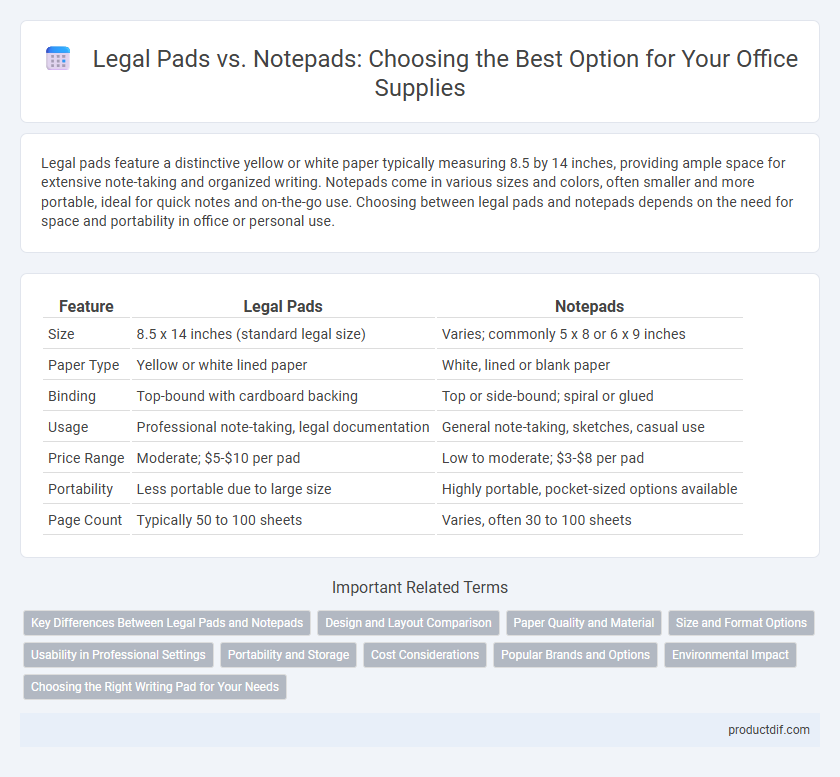Legal pads feature a distinctive yellow or white paper typically measuring 8.5 by 14 inches, providing ample space for extensive note-taking and organized writing. Notepads come in various sizes and colors, often smaller and more portable, ideal for quick notes and on-the-go use. Choosing between legal pads and notepads depends on the need for space and portability in office or personal use.
Table of Comparison
| Feature | Legal Pads | Notepads |
|---|---|---|
| Size | 8.5 x 14 inches (standard legal size) | Varies; commonly 5 x 8 or 6 x 9 inches |
| Paper Type | Yellow or white lined paper | White, lined or blank paper |
| Binding | Top-bound with cardboard backing | Top or side-bound; spiral or glued |
| Usage | Professional note-taking, legal documentation | General note-taking, sketches, casual use |
| Price Range | Moderate; $5-$10 per pad | Low to moderate; $3-$8 per pad |
| Portability | Less portable due to large size | Highly portable, pocket-sized options available |
| Page Count | Typically 50 to 100 sheets | Varies, often 30 to 100 sheets |
Key Differences Between Legal Pads and Notepads
Legal pads feature a standard size of 8.5 x 14 inches with a left-side margin line typically set at 1.25 inches, designed for organized note-taking and legal documentation. Notepads vary widely in size and often lack ruled margins, making them more versatile for casual use, sketches, or general notes. The paper weight and ruling style in legal pads are standardized for professional environments, while notepads prioritize convenience and portability without consistent formatting.
Design and Layout Comparison
Legal pads feature a distinctive top-bound design with a margin line typically set at 1.25 inches from the left edge, facilitating structured note-taking and ease of reference for legal documentation. Notepads generally offer a variety of binding options, such as glued top or spiral binding, with more flexible layouts including blank, lined, or grid paper to suit diverse writing styles. The consistent width and ruled spacing of legal pads optimize organization for formal use, while notepads provide customizable formats tailored to creative or informal note-taking needs.
Paper Quality and Material
Legal pads typically feature high-quality, acid-free paper with a smooth finish designed for easy writing and durability, whereas notepads often vary widely in paper quality, ranging from recycled to standard bond paper. The material of legal pads generally consists of thicker, more robust paper stock, enhancing crease resistance and reducing ink bleed-through compared to many notepads. These characteristics make legal pads preferable for formal documentation, while notepads serve well for casual note-taking and varied office uses.
Size and Format Options
Legal pads typically measure 8.5 x 14 inches and feature lined paper with a vertical margin for note organization, making them ideal for legal and professional use. Notepads vary widely in size, commonly ranging from 5 x 8 to 8.5 x 11 inches, and offer diverse formats including lined, blank, and grid paper to accommodate different writing and drawing needs. The choice between legal pads and notepads depends on preferred size, paper layout, and specific user requirements for note-taking or documentation.
Usability in Professional Settings
Legal pads feature narrow-ruled lines and a standardized 8.5 x 14-inch size, making them ideal for detailed note-taking and legal documentation in professional settings. Notepads, available in various sizes and layouts, offer greater versatility for quick notes or informal meetings but may lack the formal structure needed in legal or corporate environments. Choosing between legal pads and notepads depends on the specific requirements for organization, legibility, and the nature of professional tasks.
Portability and Storage
Legal pads typically measure 8.5 by 14 inches, making them less portable and more cumbersome to store compared to standard notepads, which often come in compact sizes like 5 by 8 inches. Notepads are designed for easy transport in bags or pockets, offering better convenience for on-the-go note-taking. Legal pads require more desk space and larger storage solutions, while notepads fit efficiently into smaller compartments or organizers.
Cost Considerations
Legal pads typically cost more than standard notepads due to their larger size and perforated sheets, often priced between $2 to $5 per pad. Notepads offer a more budget-friendly option, with prices ranging from $1 to $3 depending on size and paper quality. Choosing between the two depends on balancing functional needs with office supply budget constraints.
Popular Brands and Options
Legal pads and notepads differ primarily in size and ruling, with legal pads typically measuring 8.5 x 14 inches and featuring a distinctive yellow color, while notepads come in various sizes and colors. Popular brands for legal pads include Ampad and Rediform, known for high-quality paper and durability, whereas notepad options are widely offered by brands like Moleskine, Five Star, and Staples, catering to both professional and casual note-taking needs. Choosing between the two depends on specific office requirements, with legal pads favored for formal documentation and notepads preferred for versatility and portability.
Environmental Impact
Legal pads often use more paper due to their larger size and longer pages, which can increase overall environmental impact compared to smaller notepads. Notepads typically consume less paper and may offer more eco-friendly options, such as recycled paper or sustainably sourced materials. Choosing recycled or FSC-certified legal pads and notepads significantly reduces deforestation and lowers carbon footprints associated with office supplies.
Choosing the Right Writing Pad for Your Needs
Legal pads offer lined, wide-ruled paper ideal for detailed note-taking and professional writing, typically measuring 8.5 x 14 inches which provides extra space compared to standard notepads. Notepads come in various sizes, often compact and portable, making them suitable for quick jotting or casual use, with options including grid or blank pages for more versatile applications. Selecting between legal pads and notepads depends on your specific needs such as paper size preference, line spacing, and intended use environment to enhance writing efficiency and convenience.
Legal Pads vs Notepads Infographic

 productdif.com
productdif.com